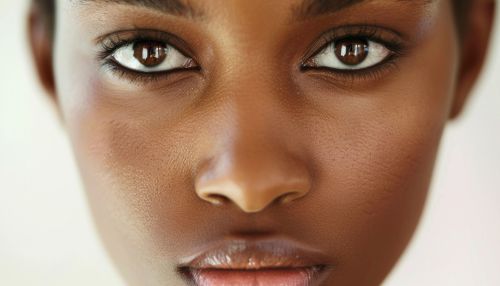Facial Symmetry: Difference between revisions
(Created page with "== Introduction == Facial symmetry refers to the degree of similarity between the left and right sides of the face. It is a significant aspect of human aesthetics and has been studied extensively in various fields such as anthropology, psychology, biology, and cosmetic surgery. Facial symmetry is often associated with attractiveness, health, and genetic fitness. == The Science of Facial Symmetry == === Genetic Basis === Facial symmetry...") |
No edit summary |
||
| Line 87: | Line 87: | ||
== References == | == References == | ||
[[Image:Detail-91623.jpg|thumb|center|Close-up of a symmetrical human face with balanced features and clear skin.|class=only_on_mobile]] | |||
[[Image:Detail-91624.jpg|thumb|center|Close-up of a symmetrical human face with balanced features and clear skin.|class=only_on_desktop]] | |||
[[Category:Anthropology]] | [[Category:Anthropology]] | ||
[[Category:Psychology]] | [[Category:Psychology]] | ||
[[Category:Biology]] | [[Category:Biology]] | ||
Latest revision as of 10:01, 20 June 2024
Introduction
Facial symmetry refers to the degree of similarity between the left and right sides of the face. It is a significant aspect of human aesthetics and has been studied extensively in various fields such as anthropology, psychology, biology, and cosmetic surgery. Facial symmetry is often associated with attractiveness, health, and genetic fitness.
The Science of Facial Symmetry
Genetic Basis
Facial symmetry is largely influenced by genetic factors. The developmental stability of an organism, which refers to its ability to produce a consistent phenotype despite genetic and environmental perturbations, plays a crucial role. Genes involved in cell growth, differentiation, and tissue repair contribute to the symmetrical development of facial features. Mutations or disruptions in these genes can lead to asymmetries.
Environmental Influences
Environmental factors such as nutrition, disease, and trauma can also impact facial symmetry. For instance, malnutrition during critical periods of growth can lead to asymmetrical development. Similarly, diseases that affect bone or tissue growth can result in facial asymmetries. Trauma to the face, whether from accidents or surgical procedures, can also cause deviations from symmetry.
Measurement of Facial Symmetry
Techniques
Several techniques are used to measure facial symmetry, ranging from simple visual assessments to advanced imaging technologies. Photogrammetry, 3D scanning, and cephalometric analysis are commonly employed methods. These techniques allow for precise measurements of facial landmarks and the calculation of symmetry indices.
Indices and Ratios
Various indices and ratios are used to quantify facial symmetry. The Symmetry Index (SI) and the Procrustes Analysis are popular methods. These indices compare the distances between corresponding facial landmarks on the left and right sides of the face. Lower values indicate higher symmetry.
Evolutionary Perspectives
Sexual Selection
Facial symmetry is often considered an indicator of genetic quality and health, making it a key factor in sexual selection. Studies have shown that individuals with symmetrical faces are perceived as more attractive and are more likely to be chosen as mates. This preference is thought to be an evolutionary adaptation to select for healthy and genetically fit partners.
Survival and Reproduction
Symmetrical faces are also associated with better survival and reproductive success. Individuals with symmetrical features are less likely to suffer from congenital anomalies and are more likely to have robust immune systems. This enhances their chances of survival and successful reproduction.
Psychological Implications
Perception of Attractiveness
Facial symmetry plays a significant role in the perception of attractiveness. Studies have shown that people tend to find symmetrical faces more appealing. This preference is consistent across different cultures and age groups, suggesting a universal standard of beauty.
Social and Psychological Effects
Individuals with symmetrical faces often experience social advantages. They are perceived as more trustworthy, competent, and sociable. These perceptions can lead to better social interactions and opportunities. Conversely, facial asymmetry can sometimes be associated with negative social and psychological outcomes, such as lower self-esteem and social anxiety.
Clinical Applications
Cosmetic Surgery
Facial symmetry is a primary goal in cosmetic surgery. Procedures such as rhinoplasty, facelift, and orthognathic surgery aim to enhance facial symmetry. Surgeons use advanced imaging and planning techniques to achieve optimal results.
Orthodontics
In orthodontics, achieving facial symmetry is crucial for both aesthetic and functional outcomes. Treatments such as braces and jaw alignment procedures are designed to correct asymmetries and improve overall facial harmony.
Reconstructive Surgery
Reconstructive surgery often focuses on restoring facial symmetry following trauma or congenital defects. Techniques such as bone grafting, tissue expansion, and flap surgery are used to reconstruct symmetrical facial features.
Cultural and Historical Perspectives
Ancient Civilizations
The importance of facial symmetry can be traced back to ancient civilizations. In Ancient Greece, symmetry was considered a key element of beauty, as reflected in their art and sculpture. The Golden Ratio, a mathematical concept associated with aesthetic perfection, was often applied to facial proportions.
Modern Standards
In contemporary society, facial symmetry continues to be a standard of beauty. Media and popular culture often emphasize symmetrical faces, influencing societal perceptions of attractiveness. This has led to a growing demand for cosmetic procedures aimed at enhancing facial symmetry.
Research and Future Directions
Genetic Research
Ongoing research aims to identify specific genes involved in facial symmetry. Advances in genomics and CRISPR technology hold promise for understanding the genetic basis of symmetry and potentially correcting asymmetries at the genetic level.
Technological Innovations
Technological advancements in imaging and surgical techniques are continually improving the ability to measure and enhance facial symmetry. Innovations such as robotic surgery and AI-driven diagnostics are expected to revolutionize the field.
See Also
References


